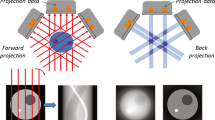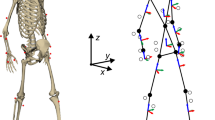Abstract
Purpose
Robotic radiotherapy can precisely ablate moving tumors when time latencies have been compensated. Recently, relevance vector machines (RVM), a probabilistic regression technique, outperformed six other prediction algorithms for respiratory compensation. The method has the distinct advantage that each predicted point is assumed to be drawn from a normal distribution. Second-order statistics, the predicted variance, were used to control RVM prediction error during a treatment and to construct hybrid prediction algorithms.
Methods
First, the duty cycle and the precision were correlated to the variance by interrupting the treatment if the variance exceeds a threshold. Second, two hybrid algorithms based on the variance were developed, one consisting of multiple RVMs (\(\hbox {HYB}_{\textit{RVM}}\)) and the other of a combination between a wavelet-based least mean square algorithm (wLMS) and a RVM (\(\hbox {HYB}_{\textit{wLMS}-\textit{RVM}}\)). The variance for different motion traces was analyzed to reveal a characteristic variance pattern which gives insight in what kind of prediction errors can be controlled by the variance.
Results
Limiting the variance by a threshold resulted in an increased precision with a decreased duty cycle. All hybrid algorithms showed an increased prediction accuracy compared to using only their individual algorithms. The best hybrid algorithm, \(\hbox {HYB}_{\textit{RVM}}\), can decrease the mean RMSE over all 304 motion traces from \(0.18\,\)mm for a linear RVM to \(0.17\,\)mm.
Conclusions
The predicted variance was shown to be an efficient metric to control prediction errors, resulting in a more robust radiotherapy treatment. The hybrid algorithm \(\hbox {HYB}_{\textit{RVM}}\) could be translated to clinical practice. It does not require further parameters, can be completely parallelised and easily further extended.







Similar content being viewed by others
Notes
This results in some minor differences in the prediction accuracy compared to [2].
References
Depuydt T, Haas O, Verellen D, Erbel S, De Ridder M, Storme G (2010) Geometric accuracy evaluation of the new VERO stereotactic body radiation therapy system. In: Burnham KJ, Ersanilli VE (eds) Proceedings of the UKACC international conference on control. Cambridge, UK, pp 613–619
Dürichen R, Wissel T, Ernst F, Schweikard A (2013) Respiratory motion compensation with relevance vector machines. In: Medical image computing and computer-assisted intervention MICCAI 2013. Lecture notes in computer science, vol 8150. Springer, Berlin, pp 108–115
Ernst F, Dürichen R, Schlaefer A, Schweikard A (2013) Evaluating and comparing algorithms for respiratory motion prediction. Phys Med Biol 58(11):3911–3929
Ernst F, Schlaefer A, Schweikard A (2007) Prediction of respiratory motion with wavelet-based multiscale autoregression. In: Medical image computing and computer-assisted intervention MICCAI 2007, vol 4792. Springer, Berlin, pp 668–675
Giraud P, De Rycke Y, Dubray B, Helfre S, Voican D, Guo L, Rosenwald JC, Keraudy K, Housset M, Touboul E, Cosset JM (2001) Conformal radiotherapy (CRT) planning for lung cancer: analysis of intrathoracic organ motion during extreme phases of breathing. Int J Radiat Oncol* Biol* Phys 51(4):1081–1092
Liu W, Prncipe J (2008) Kernel affine projection algorithms. EURASIP J Adv Signal Process 2008(1):784292
Rasmussen CE, Williams CKI (2006) Gaussian processes in machine learning. MIT Press, Cambridge
Ruan D (2010) Prospective detection of large prediction errors: a hypothesis testing approach. Phys Med Biol 55(13):3885
Sayeh S, Wang J, Main WT, Kilby W, Calvin RM (2007) Respiratory motion tracking for robotic radiosurgery. In: Treating tumors that move with respiration. Springer, Berlin, pp 15–29
Seppenwoolde Y, Berbeco RI, Nishioka S, Shirato H, Heijmen B (2007) Accuracy of tumor motion compensation algorithm from a robotic respiratory tracking system: a simulation study. Med Phys 34(7):2774
Seppenwoolde Y, Shirato H, Kitamura K, Shimizu S, van Herk M, Lebesque JV, Miyasaka K (2002) Precise and real-time measurement of 3D tumor motion in lung due to breathing and heartbeat, measured during radiotherapy. Int J Radiat Oncol * Biol * Phys 53(4):822–834
Tipping ME (2001) Sparse bayesian learning and the relevance vector machine. J Mach Learn Res 1:211–244
Conflict of interest
Robert Dürichen, Tobias Wissel and Achim Schweikard declare that they have no conflict of interest.
Author information
Authors and Affiliations
Corresponding author
Rights and permissions
About this article
Cite this article
Dürichen, R., Wissel, T. & Schweikard, A. Controlling motion prediction errors in radiotherapy with relevance vector machines. Int J CARS 10, 363–371 (2015). https://doi.org/10.1007/s11548-014-1008-x
Received:
Accepted:
Published:
Issue Date:
DOI: https://doi.org/10.1007/s11548-014-1008-x




